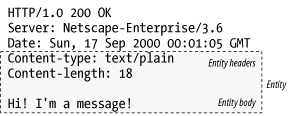Messages Are Crates, Entities Are Cargo
If you think of HTTP messages as the crates of the Internet shipping system, then HTTP entities are the actual cargo of the messages. Figure 15-1 shows a simple entity, carried inside an HTTP response message.

Figure 15-1. Message entity is made up of entity headers and entity body
The entity headers indicate a plaintext document (Content-Type: text/plain) that is a mere 18 characters long (Content-Length: 18). As always, a blank line (CRLF) separates the header fields from the start of the body.
HTTP entity headers (covered in Chapter 3) describe the contents of an HTTP message. HTTP/1.1 defines 10 primary entity header fields:
- Content-Type
The kind of object carried by the entity.
- Content-Length
The length or size of the message being sent.
- Content-Language
The human language that best matches the object being sent.
- Content-Encoding
Any transformation (compression, etc.) performed on the object data.
- Content-Location
An alternate location for the object at the time of the request.
- Content-Range
If this is a partial entity, this header defines which pieces of the whole are included.
- Content-MD5
A checksum of the contents of the entity body.
- Last-Modified
The date on which this particular content was created or modified at the server.
- Expires
The date and time at which this entity data will become stale.
- Allow
What request methods are legal on this resource; ...
Get HTTP: The Definitive Guide now with the O’Reilly learning platform.
O’Reilly members experience books, live events, courses curated by job role, and more from O’Reilly and nearly 200 top publishers.

